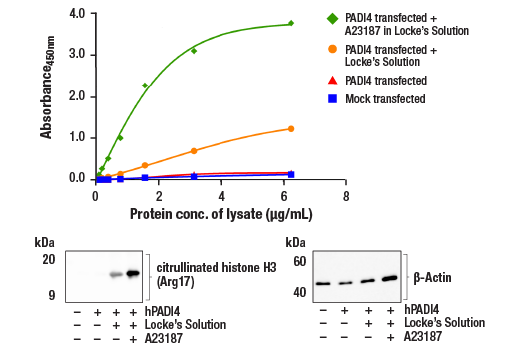| Product Includes | Product # | Quantity | Color |
|---|---|---|---|
| FastScan™ ELISA Microwell Strip Plate, 96 Well | 53257 | 96 tests | |
| Histone H3 Rabbit Capture mAb | 10606 | 1 ea | Green (Lyophilized) |
| Citrullinated Histone H3 (Arg17) Rabbit HRP-linked mAb | 28967 | 1 ea | Red (Lyophilized) |
| FastScan™ ELISA Capture Antibody Diluent | 16076 | 3 ml | Green |
| FastScan™ ELISA HRP Antibody Diluent | 28120 | 3 ml | |
| TMB Substrate | 7004 | 11 ml | |
| STOP Solution | 7002 | 11 ml | |
| Sealing Tape | 54503 | 1 ea | |
| ELISA Wash Buffer (20X) | 9801 | 25 ml | |
| FastScan™ ELISA Cell Extraction Buffer (5X) | 69905 | 10 ml | |
| FastScan™ ELISA Cell Extraction Enhancer Solution (50X) | 25243 | 1 ml | |
| FastScan™ ELISA Kit #82818 Positive Control Type 2 | 96313 | 1 ea |
*The microwell plate is supplied as 12 8-well modules - Each module is designed to break apart for 8 tests.
Description
The FastScan™ Citrullinated Histone H3 (Arg17) ELISA Kit is a sandwich enzyme-linked immunosorbent assay (ELISA) that detects endogenous levels of histone H3 when citrullinated at Arg17. To perform the assay, sample is incubated with a capture antibody conjugated with a proprietary tag and a second detection antibody linked to HRP, forming a sandwich with citrullinated histone H3 (Arg17) in solution. This entire complex is immobilized to the plate via an anti-tag antibody. The wells are then washed to remove unbound material. TMB is then added. The magnitude of observed signal is proportional to the quantity of citrullinated histone H3 (Arg17).
*Antibodies in kit are custom formulations specific to kit.
IMPORTANT: This FastScan™ ELISA Kit requires 4 washes at Step 6 of the protocol.
Specificity/Sensitivity
Background
The nucleosome, made up of four core histone proteins (H2A, H2B, H3, and H4), is the primary building block of chromatin. Histone post-translational modifications, such as methylation, acetylation, ubiquitination, and citrullination, influence chromatin accessibility and regulate gene expression (1). Histone citrullination is carried out by protein arginine deiminases (PADs), which convert positively charged arginine residues into neutral citrulline (2). Histone citrullination affects the binding of histone reader proteins to chromatin, and it is associated with both transcriptional activation and repression (3-5). Histone citrullination is also a major marker for NETosis, which is a programmed cell death mechanism carried out by neutrophils (6). De-regulation of NETosis is associated with multiple autoimmune diseases, including rheumatoid arthritis (RA) and lupus (7,8). Histone hypercitrullination via PAD4 may also play a role in the progression of various cancers, including multiple myeloma (MM), acute myeloid leukemia (AML), lung cancer, and hepatocellular carcinoma (HCC) (9-12).
- Shanmugam, M.K. et al. (2018) Oncotarget 9, 11414-11426.
- Fuhrmann, J. and Thompson, P.R. (2016) ACS Chem Biol 11, 654-68.
- Wang, Y. et al. (2004) Science 306, 279-83.
- Cuthbert, G.L. et al. (2004) Cell 118, 545-53.
- Zhang, X. et al. (2012) Proc Natl Acad Sci U S A 109, 13331-6.
- Hamam, H.J. and Palaniyar, N. (2019) Biomolecules 9, 369. doi: 10.3390/biom9080369.
- Corsiero, E. et al. (2016) Front Immunol 7, 485.
- Hakkim, A. et al. (2010) Proc Natl Acad Sci U S A 107, 9813-8.
- McNee, G. et al. (2017) Leukemia 31, 373-381.
- Song, G. et al. (2016) Oncotarget 7, 3144-57.
- Tanikawa, C. et al. (2012) Nat Commun 3, 676.
- Lu, M. et al. (2020) J Med Virol 92, 1221-1230.
Background References
Cross-Reactivity Key
H: human M: mouse R: rat Hm: hamster Mk: monkey Vir: virus Mi: mink C: chicken Dm: D. melanogaster X: Xenopus Z: zebrafish B: bovine Dg: dog Pg: pig Sc: S. cerevisiae Ce: C. elegans Hr: horse GP: Guinea Pig Rab: rabbit All: all species expected
Trademarks and Patents
使用に関する制限
法的な権限を与えられたCSTの担当者が署名した書面によって別途明示的に合意された場合を除き、 CST、その関連会社または代理店が提供する製品には以下の条件が適用されます。お客様が定める条件でここに定められた条件に含まれるものを超えるもの、 または、ここに定められた条件と異なるものは、法的な権限を与えられたCSTの担当者が別途書面にて受諾した場合を除き、拒絶され、 いかなる効力も効果も有しません。
研究専用 (For Research Use Only) またはこれに類似する表示がされた製品は、 いかなる目的についても FDA または外国もしくは国内のその他の規制機関により承認、認可または許可を受けていません。 お客様は製品を診断もしくは治療目的で使用してはならず、また、製品に表示された内容に違反する方法で使用してはなりません。 CST が販売または使用許諾する製品は、エンドユーザーであるお客様に対し、使途を研究および開発のみに限定して提供されるものです。 診断、予防もしくは治療目的で製品を使用することまたは製品を再販売 (単独であるか他の製品等の一部であるかを問いません) もしくはその他の商業的利用の目的で購入することについては、CST から別途許諾を得る必要があります。 お客様は以下の事項を遵守しなければなりません。(a) CST の製品 (単独であるか他の資材と一緒であるかを問いません) を販売、使用許諾、貸与、寄付もしくはその他の態様で第三者に譲渡したり使用させたりしてはなりません。また、商用の製品を製造するために CST の製品を使用してはなりません。(b) 複製、改変、リバースエンジニアリング、逆コンパイル、 分解または他の方法により製品の構造または技術を解明しようとしてはなりません。また、 CST の製品またはサービスと競合する製品またはサービスを開発する目的で CST の製品を使用してはなりません。(c) CST の製品の商標、商号、ロゴ、特許または著作権に関する通知または表示を除去したり改変したりしてはなりません。(d) CST の製品をCST 製品販売条件(CST’s Product Terms of Sale) および該当する書面のみに従って使用しなければなりません。(e) CST の製品に関連してお客様が使用する第三者の製品またはサービスに関する使用許諾条件、 サービス提供条件またはこれに類する合意事項を遵守しなければなりません。
